Chapter 12. Saturn's Dramatic Rings
12.1 Introduction

Author: Janelle M. Bailey, University of Nevada, Las Vegas
Editor: Beth Hufnagel, Anne Arundel Community College

Voyager 2
The goals of this module: After completing this exercise, you should be able to:
- Explain why Saturn's rings appear different over time.
- Describe features of Saturn's rings.
- Explain how Saturn's rings (and planetary rings in general) were probably formed
In this module you will explore:
- The visual and physical properties of Saturn's rings.
- The interplay of forces - gravitational, tidal, and electromagnetic - that formed and sustain planetary rings.
Why you are doing it: Saturn's rings are one of the most beautiful sights in our Solar System, and understanding them will help us understand how planets and their moons formed and change over time.
12.2 Background
In 1610, Galileo turned his telescope toward Saturn and observed what looked like "ears" or "lumps" on the sides of the planet. It wasn't until 1655, when Christiaan Huygens observed the planet with a more powerful telescope, that those "ears" were seen to be a large ring around the planet. Observations through better telescopes and from spacecraft have revealed a beautiful complexity: what at first appeared to be a single, large disk around the planet is now known to be made from thousands of tiny rings. In this module, we will explore those rings in more detail.
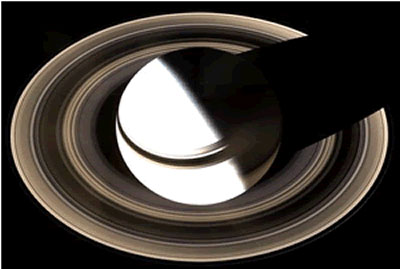
12.3 Viewing Saturn's Rings
Imagine that you received a new telescope for your birthday. When would be the best time to use it to look at Saturn's rings?
The following diagram shows Saturn in two special positions in its orbit, conjunction and opposition, compared to Earth's position in its orbit.
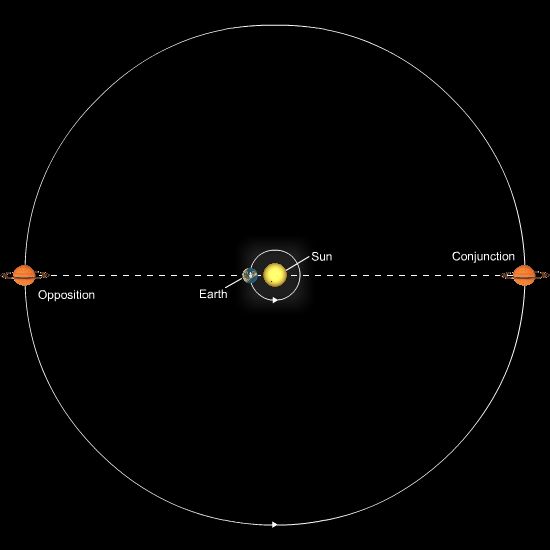
Question Sequence
Question 12.1
6LdCGsuz33weyr6zeFKKT0IjmoDrswJwD1uN+h8uj3fKc17fBCeSVAymz85yUCX6q09etIgaWGVAOKLa3tPRUXoyUbkRstkk6LgzOG+xaZl1vuN40VzVxIVDJCMdJJjtimn9VRgnNzCdMFA80cKuPuWxV5iiR7pC4OV0hl53iKyGO4IjyJJbwi9nYNptqOHqPc69U4WK++ycBEBQ1rE5GHaHS+gM6W7SpHPgzVBmfGwY/WnpifsaUz6nx3AUv+tdZgC3k+ENhcCzymfkRu+nq8RvwU1rksJSeAxL1To+BL1paw3Xe32clQkKj7/kTVOePzMCvTBGgJTKueYVylLPkzBOFEWB/Qo0AQfIqHrka8k6i/WOGPChD3G2ttjUxPVymk2w8mv6WX1Pv8r84GmA869dApdAqP4rVfbCz7R2YUuPbFShfSg6wtv9XN5+mjzZYtiqUtpe8PPxP2vpZeM/siCrHvzyfayr9aR/MYifTItN/9zuQuestion 12.2
H2owk0amzXumrNhdwv56jabL45aDgk/uQfP8VUjZDNSUkdZxRicsU0Np0EJE2hWkdXlagYsPkCHUDyxFlNwFLmerbNuE8CB6f1h4ghWSpObOvEoFD4VKd9tgHpi51AWB7ljwWGN1/pJ3BFhnE4dxh5QBTj41J1+y2s08CRb9KIgniH28BHekS5tS1QqCyrGyU3kROZkvtN941ajIk1OCi2xz++kj1bsPGvCWMEhtov/cVEYik9/3qZovELexaB3wy1/MQHRCCvdyteKijAHNnvIbQjTobrxt7/yVRLwNYSpoX8l0l3Lz22CwLGMlPiGdBjZE7RR+/tBaA06kteqRzUtpajmCYgp9/R5xx9coTYbCogbaWapTalJzLVg7hwYuV1cTo4LS8r6TMdu5glFo7pTCiMusIjWZKym374JeBXdtYaZ3qWbNW8EHE9ESVDIWHPZdMREPbwRPrQuzUOPGyVhq9c7n19EydUz939VgTN4C2rWJCnArDSv9IVWCJnuyzbTyXz2JHc6TngFk/LvBT9nGXjH1fSAJm2OKEE1PBGJU1egk2frBg5L8hUQIJQzlEDJ/SF0onY00NLLWOla8FbLa30wQCAaQpt9HP9TXXFVj+1eSZQrSXjwByJ+R/zXoyhQoDq5B2vhGyyJ+kbaDiiHeETT7WJY9tICJlNKtth714rQ9soOgmBRCPkbK5A8HyNRAoN20mUmqcsS9m69cpPW6G+dDUoZ5FGTAdx9xjyeye/wMdlPPRILjCLn0KaGxKUTxZomHuaRVm65h0OM7MZuX8mEoUQ6HEHqPsBEhszk1c9y3nqBMoWTpUGzS5mWqThWLtlg4sWRVuKGoPWhCsOnlks/ZXaqLMmNIQ0RAll2wxufmyZ8PuQwYIaowxT2e12.4 The Mystery of the Disappearing Rings
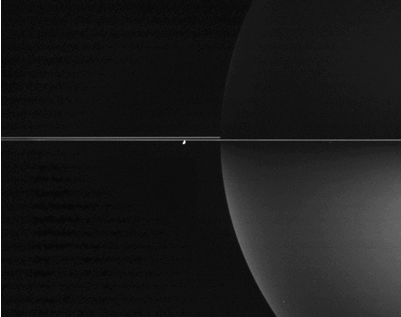
When astronomers first began to observe Saturn, they noticed that the lumps on the sides seemed to disappear aNd reappear over time. When Huygens proposed that the lumps were actually a large but thin ring around the planet, he also predicted that the ring should be visible only in certain orientations. In other words, sometimes the ring would be tilted facing toward us so that we could see it, while other times we would not be able to see the ring as we viewed it edge-on. His predictions turned out to be correct!
You may know that Earth's axis is tilted by 23.5° relative to the plane of its orbit, and that it remains pointed in the same direction all year long. (Earth's Northern Pole points at the star called Polaris all year.) Saturn's axis is tilted just slightly more than Earth's (27°) and it also points in one direction throughout its entire 29-year orbit of the Sun.
The animation below shows how the appearance of Saturn's rings changes as Earth and Saturn orbit the Sun. Use the animation to help you answer the following question.
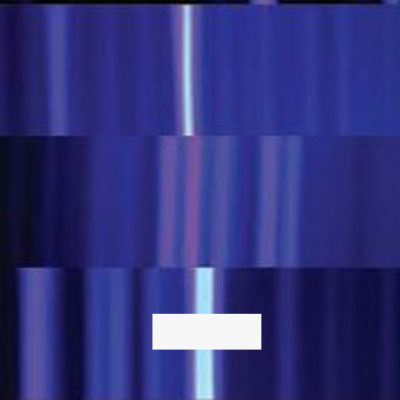

Question 12.3
4cr7F9UGUVZGOR6nFNYvhD7AYFrIS1Eo0bLjQLfAm3RA7s7Rz8ETZJHT86t6juYQ6qKEuoqjMHJWQLgPVqexGQS6OILLMr1X8n1lHrta4tTcQ6Esp4LZq6a6vM35XcZEtWjJQTP0vtQL7SYE9XAIQm/cwXi8KXY61wa/Wq4V27oZcey53BRfcnvvcrtaq6fCunu+4a4sexo/+GmdPHtgEwiNTS4y2q00ajG0WwWOpFIqWgen3s/X6RBrz8wGKrz/5mpnxuavn5GaVrR7Kjmc5r3dxTDUAnBeanZ0QoMigk9SL8fArLYuli14wfPUH0IdT94AInXS62a3W1WGqLdmOBeQ8HXuHYBU6nfJrMBMcVOo86XbZxZLHODlRpD48aP7o2Wgs6NfqjjhbI1scIfSY8CY4SJWwoGhEgQE21yDzh9qTw0uVJ1nPNESawQHVuKIGdk5AzODveAbMhabX6skHEMKQYWZS9+JWG6wb2TuEY5LoCyE/5IPlCzVOCwOXk7pPeerbxVZHzw=12.5 The Detailed Structure of the Rings
Looking at Saturn's rings through even a small telescope reveals quite a lot of detail. In 1675, an Italian astronomer named Cassini observed that there is a dark gap in the ring - it appeared to be two rings rather than just one. (This gap is now called the Cassini division, and separates the outer A ring from the inner B ring.) Later, a faint ring even closer to the planet was discovered and named the C ring.
In the late 1970s and early 1980s, spacecraft began to fly by Saturn. Observations from Pioneer 11, Voyager 1, and Voyager 2 sent the first detailed images of Saturn's rings back to Earth. The Cassinimission, which arrived at Saturn in 2004, has expanded our knowledge of the rings even further.

Question 12.4
npHuXgQ0buTqtgOcjRxjNS4awMFHCwEj5ymDzpZPu+hl6/xv//TWAuZIcND2VzC0LO1T+r47rlg8epKqkPpYLuPRkePavUMBYSFLwCTQl/6ab0+p38ahI1cqpXEmEzfu6yYllA==Summary
Thanks to the many spacecraft observations, astronomers have now identified seven major rings labeled A-G, and numerous smaller rings. Telescopes and spacecraft have shown that there are many narrow rings rather than just one large disk, but what are these rings made of?
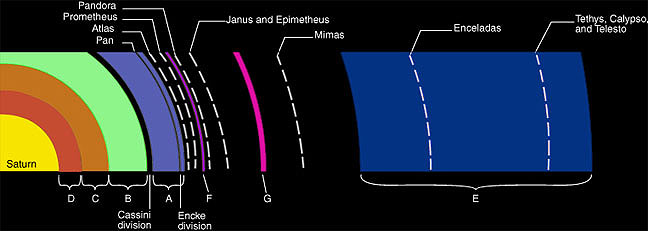
12.6 The Composition of the Rings
For many years, astronomers theorized that the rings might actually be made of thousands of small particles. If it were a single sheet of material, gravitational forces from Saturn would pull on the inner and outer portions with significantly different strengths, causing the rings to break apart. This idea of tides caused by Saturn was proven mathematically by James Clerk Maxwell in 1857.
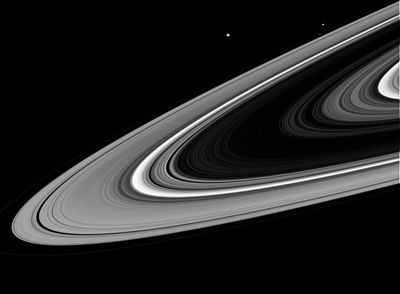
In 1895, James Keeler used spectroscopy to observe Saturn's rings. He saw that the amount by which the light was Doppler shifted was largest closest to the planet, indicating that the interior rings are moving faster than the exterior rings. In fact, the speeds followed the same rules as the planets do as they orbit the Sun. This observation, combined with Maxwell's calculations, showed that the rings must be made of thousands of small particles.
The rings reflect 80% of the sunlight that hits them, suggesting that the particles are made of ice (or ice-coated rock). The sizes of the particles range from only pebble-sized, about 1 cm in diameter, to larger chunks about 5 m across - as big as a minivan! Most are thought to be about 10 cm in diameter, or about the size of a snowball.
To make things more complicated, observations have revealed dark areas that run across the rings, similar to spokes on a wheel. The particles in these spokes are tiny and not coated with ice, and were not predicted!
Observations from Voyager 1 showed that Saturn's rings are divided into thousands of narrow ringlets. The 'spokes' are thought to reveal the presence of small, electrically charged particles that respond to Saturn's magnetic field.
12.7 Where did the Rings Come From?
So how did Saturn end up as the only planet with so many ice particles around it? Astronomers think that the particles may be debris from the early Solar System - either material that didn't coalesce into a moon, or a moon that broke apart because it was too close to Saturn.
Any particle is gravitationally attracted to other particles around it, just as those other particles are attracted to it. The larger their masses, the stronger the attraction to each other. Also, the closer they are to each other, the stronger the attraction. This mutual attraction will cause these small particles to come together, eventually colliding and forming larger and larger chunks.
At the same time these small particles are pulling on one another, Saturn itself is also pulling on those particles. The gravitational force is stronger on material that is closer to Saturn and weaker on material farther from the planet. This difference, called a tidal force, will keep small particles from combining or can cause a large piece of material to break apart.

These tidal forces from Saturn will compete against the gravitational forces trying to keep the smaller particles together. Inside a particular distance from Saturn, called its Roche Limit, the tidal forces between Saturn and the particles will overwhelm the gravitational attraction between the particles. Outside the Roche Limit, the tidal forces are weaker than the attraction between particles.
But this doesn't explain Saturn's G and E rings, which lie outside of Saturn's Roche Limit. It is thought that the moon Enceladus supplies the material for the E ring. Based on evidence from the Cassini mission, scientists think that the G ring is influenced by the moon Mimas, which, as we will see in the next section, also influences the Cassini division.
Open the animation and use it to answer the following questions. Note that in the later part of the animation, the planets have been scaled to the same size, and the rings have been scaled to match.
Question Sequence
Question 12.5
Rc4shfv470PhLNlgLyUhPtdWQEBRE4vqM+e0mhQw3yoGOGZuDGBOpaMnF4q3LA1wU7GJy4bF4gBUnB4OlVSsAG0jDAx5p2kpFkWjEqZsLb5lJXhhkG37p0SEH9m/p5HSVpLkmuQeQF98J86HZpILGOIESDeR5TkCpjA3GkfQNMSHQ8U2k2S8ng3wx/kmYq10Question 12.6
yVGfWHwkaMi2DE0GfW8reFaTJB63zIprFGzUrMyOIbp/V8aYhtqgeSFp1MozbtEMuiyT4Z9yt6HM9Jimh39XSp7bmZNH2vqY0Z8MwqdB/M+RpFulu4xJI8+zmpwPPwzSfw7Bh0rTKaFEEkXvvE/HYHqg5tM=Summary
Apparently the small fragments can still maintain their shape while they orbit the planet - why are they not broken further apart if they are inside the Roche Limit? The primary forces that hold the particles together at this size are chemical, not gravitational. The particles are gravitationally attracted to each other, but their mass is too small for gravity to be significant. Just like rocks here on the surface of Earth, it is chemical bonds that hold the various atoms and molecules together into a sizeable chunk of material.
12.8 Shepherd Moons

The many moons - natural satellites - of Saturn add to the complexity of the ring system. Any moons within the Roche limit must be small, to avoid being torn apart. Calculations show that particles that would be located in the Cassini division have an orbit around Saturn of only 11.3 hours. The moon Mimas, which has a diameter of approximately 392 km, orbits the planet in 22.6 hours. This means that any major particles that would be in the Cassini division would have a 2-to-1 resonance with Mimas - so at certain times, the gravitational influence of Mimas would be strong enough to disrupt the path of the particles. Over time, the particles have been swept out of this region, leaving behind the apparent gap that Cassini first observed in 1675. Other satellites probably made other gaps in the rings in a similar fashion.
Saturn's moons can have other, more complicated gravitational influences on the rings. The video below shows the interactions of the moons Prometheus and Pandora with the F ring, as seen from underneath.

The gravitational influence of Prometheus and Pandora cause the orbiting particles to remain confined into a very narrow region. These moons, and others that influence other rings in the same way, are called shepherd moons.
Question 12.7
ycBr7q3Q37wNZnO4JOO5eD4pKmPmdnxvLv+YS8/KjS8phDmWtyMaFqjwr3OoI2Snb0ku3tWGqp5ouY1TLKcnhGUqa46tCdHTbwIwdCGdqVjMaO1T8N0vkNCQ3SfkrwSI2YVdIe6l8KsuJxfDDfn/9MjljCpw5xPqI6DH1JLYb9gepVYJ4aRVoijmb+mCjXcgnES0iQy1CPhnN2k4NvkVKTQ4tK3+HAIKbaF9as1UX2ZY9ih6JG7tfg2UWirhVsmqyfGzjIS82/C+2/VxAeiE2v++eDIT/2+bsi4Su08tmfom5Z0nQnKn80/EruESPWatAt0KfntBtHJ95ekOLYDpIL0EXS7ipxwSJ3owQgpqt3nF1Yt4NK50ZOPGoUXgYpGRvsZUpiv3/83q2RVbaPMGy8Bcu9Ga4Jw+SMa1uk334alPUPzGYJ5rfX3OehLIhXwNHG1sE5Uy3QbDfPzZoc1YD8mP8j2RD517DWpuAs4Z/1aIClj9arWBbEejT4LESz9pyVicVaV589/3p+PvRZnalrlyLI7nr1hTsV2p/oXVwCaPvSS8tzypn056WQ8K3FCZB8/wKyowSN6gpjprZYPQtOFq96ZGVZddjfvIW/jObYYnqruLbEyDVwZlNyEmq8xRb/ljx2khSfg336B7qkjY1//jHePggTWdqzsajSGNenwbgboNViuzoldqWORoaq3GPsVzEchLQQknpa6PAF+LrT1952s3uS7VGiu/Nu3gPxHz2z5I21vrQzxwi7M=12.9 Summary
Now that you've had a chance to explore Saturn's rings and how we think they formed, here's another look at the rings of each of the other giant planets.
CLICK ON the first two images to hear the audio clips.

Bottom: Two Shepherd Moons of Uranus's Epsilon ring.
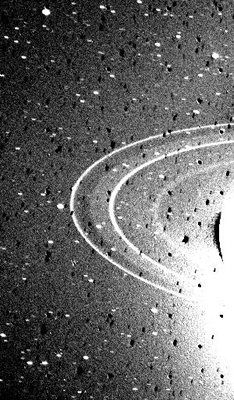
12.10 Quick Check Quiz
Indepth Activity: Saturn's Dramatic Rings